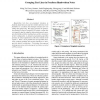Free Online Productivity Tools
i2Speak
i2Symbol
i2OCR
iTex2Img
iWeb2Print
iWeb2Shot
i2Type
iPdf2Split
iPdf2Merge
i2Bopomofo
i2Arabic
i2Style
i2Image
i2PDF
iLatex2Rtf
Sci2ools
ICDAR
2005
IEEE
2005
IEEE
Grouping Text Lines in Freeform Handwritten Notes
Handwritten text lines are prominent structures in freeform digital ink notes and their reliable detection is the foundation to a natural and intelligent interface for note editing and repurposing. This paper presents an optimization method for text line grouping. The global cost function is designed to find the simplest stroke partitioning to maximize the likelihood of the resulting lines and the consistency of their configuration. A dynamic programming algorithm provides an initial segmentation of the time-ordered stroke sequence. Then a local gradient-descent algorithm iteratively evaluates splitting and merging hypotheses to minimize the global cost function. On average, the proposed technique processes each note page in less than a second at a 90% accuracy.
| Added | 24 Jun 2010 |
| Updated | 24 Jun 2010 |
| Type | Conference |
| Year | 2005 |
| Where | ICDAR |
| Authors | Ming Ye, Herry Sutanto, Sashi Raghupathy, Chengyang Li, Michael Shilman |
Comments (0)

